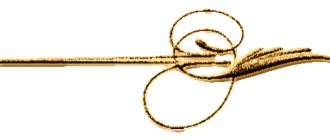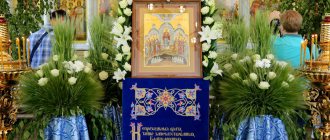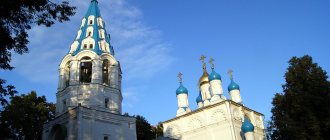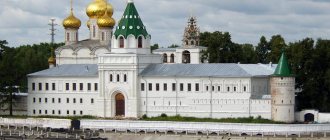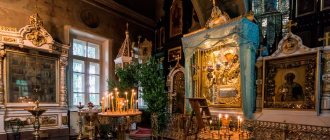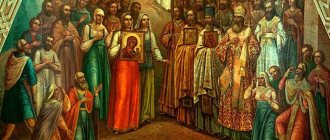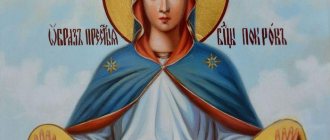Belt of the Blessed Virgin Mary
Belt of the Blessed Virgin Mary
(Greek Ζώνη τῆς ὑπεραγίας Θεοτόκου) - a Christian shrine that belonged to the Mother of God. According to Tradition, the belt was woven from camel hair by the Virgin herself, and after the Dormition during the Ascension, she gave it to the Apostle Thomas. In honor of the relic, a celebration has been established in the Orthodox Church - “The Position of the Honorable Belt of the Blessed Virgin Mary” (Greek γίας Θεοτόκου), performed on September 13 (NS). In the 10th century, the Belt of the Virgin Mary was divided into parts, which eventually ended up in Bulgaria, Georgia (Zugdidi), Mount Athos (Vatopedi Monastery), and Cyprus (Trooditissa Monastery). Pieces of the Belt are also in Russia: in the Serapion Chambers of the Trinity-Sergius Lavra, in the Kazan Cathedral in St. Petersburg and in the Church of Elijah the Prophet in Obydensky Lane in Moscow, where you can venerate them at any time.
See also: Robe of the Lord
Historical excursion[edit]
As you know, the Apostle Thomas did not participate in the burial of the Virgin Mary - at that time he was in the region of India and spread the Good News there. Only on the third day did he arrive in Jerusalem. Grieving and wanting to say goodbye to the Mother of God, he asked the apostles to open her tomb. Having opened it, the apostles were amazed, because the tomb turned out to be empty. Only the funeral shrouds remained in it, from which a wonderful fragrance emanated. “Kissing the funeral shroud remaining in the tomb with tears and reverence, they prayed to the Lord to reveal to them where the body of the Most Holy Theotokos had disappeared?” — writes Dmitry Rostovsky. In response to their question, the Mother of God appeared to the apostles at supper and greeted them with the words: “Rejoice! “For I am with you always.” However, there is a legend that on the third day, that is, before this appearance, the Mother of God appeared to the Apostle Thomas through his prayer. To console him, she threw her belt to him from the sky. This tradition is depicted on Orthodox icons, and on the holy Mount Athos there is a 6th-century fresco depicting Thomas bringing the belt to the other disciples.
The Virgin Mary gives the Belt to the Apostle Thomas
The Golden Ark, in which the belt, revered as a great shrine, was enclosed for a long time, was first discovered at the end of the 9th - beginning of the 10th century during the reign of Emperor Leo the Wise. This was done with the permission of the patriarch for the emperor’s wife Zoe, who was overwhelmed by an unclean spirit. The emperor prayed to God for the healing of his wife. And a vision occurred that she would be cured of her weakness if the belt of the Virgin Mary was placed on her. When the ark was opened, it turned out that the belt, which had lain in it for almost ten centuries, had not decayed. The Patriarch applied the Belt to the sick empress, and she immediately got rid of the unclean spirit. As a token of gratitude to the Mother of God, Zoya embroidered the entire Belt with gold thread. After these events, Saint Euthymius, the emperor’s confessor and Patriarch of Constantinople, composed a Homily “in honor of the Most Blessed Virgin Mary, in remembrance of the miracle that occurred from Her Honorable Belt, by grace, mercy and love for mankind, Christ our God was born from Her.”
In the 10th century, the Belt of the Virgin Mary was divided into parts, which eventually ended up in Bulgaria, Georgia (Zugdidi) and Cyprus (Trooditissa Monastery). Helena, the niece of the Byzantine Emperor Romanos III Argir (Argyropoulo), received healing from the belt of the Virgin Mary. When in 1028, after the war with Georgia, the emperor made peace with her, he married Helen to the Georgian king Bagrat IV Kuropalates in order to seal the political alliance. With the permission of the emperor, the bride brought part of the Belt with her to a distant country. It is known that at the beginning of the 19th century, the ruler of Megrelia Nino, the daughter of the Georgian Tsar George XII, after accepting Russian citizenship, sent the shrine as a gift to the Russian Emperor Alexander I. The reaction of the Russian Tsar is surprising. Having decorated the ark with precious stones, he sent it back and ordered to build a stone church in Zugdidi to store the shrine. And to this day this part of the Belt is kept in the Cathedral of the Blachernae Icon of the Mother of God in a precious icon case.
The Vatopedi Monastery on Mount Athos in Greece contains a part of the belt of the Blessed Virgin Mary, which the Byzantine emperors took with them on military campaigns and which the Bulgarians once recaptured from the Byzantines. This is a gift from the Serbian prince Lazar Hrebelianovich, who ruled in the 14th century - the last independent ruler of Serbia. This prince is glorified among the saints of the Serbian Orthodox Church as a great martyr. The history of the monastery is so closely intertwined with the history of the Belt that it can no longer be thought of separately from it. This is evidenced by the nickname “Agiazonites” (that is, “holy belts”), given to the Vatopedi monks on Athos. 5 Temple of the Belt of the Virgin Mary in Syria In the city of Homs (ancient Emesa) there is a temple dedicated to the Belt of the Blessed Virgin Mary, the famous “Umm Zunnar”. According to the tradition of these places, the shrine was placed in a silver flower on a stand. In the center of the plant, surrounded by openwork petals under glass, lies a thin woolen belt made of camel hair and gold threads, about 60 centimeters long, twisted into a ring. According to legend, this is part of the belt of the Virgin Mary. It was found in 1953 after an ancient manuscript in Aramaic was discovered in a monastery in Mardin (modern Turkey). This manuscript indicated the place where half of the belt was kept, which Thomas took with him. Numerous healings also occur from this part of the shrine through the prayers of believers. In Umm Zunnar, next to the niche decorated with fresh flowers, where the Belt of the Virgin Mary is kept, there is a jug. Believers throw notes into it addressed to the Heavenly Intercessor.
THE HISTORY OF THE ACQUISITION OF THE HONORABLE BELT OF THE MOTHER OF GOD
The Belt of the Blessed Virgin Mary was one of the three main shrines of Constantinople, associated with the earthly life of the Mother of God; In addition to the Belt, the Robe (more precisely, maforium) of the Virgin Mary and the icon of the Mother of God Hodegetria, painted, according to legend, by the Evangelist Luke, were kept in Constantinople. There are two stories about the origin of the belt of the Virgin Mary, one of them in the Minology of Basil II, the other in the Synaxarion of the Church of Constantinople, both sources of the 10th century. According to legend, Saint Mary herself wove a belt from camel hair. According to one version, the Most Holy Theotokos, after Her Dormition, appeared to the Apostle Thomas and gave him the belt. As is known from the scriptures, the apostle did not make it in time for the burial of the Mother of God. To console the faithful disciple of Christ, She, through his prayers, handed over the shrine into his hands. According to the legend reflected in the Menology of Basil II, the Belt and Robe of the Mother of God, shortly before Her Dormition, were given to two pious Jerusalem widows and then passed on from generation to generation.
Location. Accessibility for pilgrims[edit]
After the fall of Constantinople, several locations of parts of this relic are known:
- Vatopedi Monastery (Athos) - a gift from the Serbian prince Lazar, is considered part of the belt that the Byzantine emperors took with them on military campaigns and which the Bulgarians recaptured from the Byzantines.
- Trooditissa Monastery (Cyprus)
- The Blachernae Church in Zugdidi (Georgia) is a part brought by the niece of Emperor Roman III, who became the wife of the Georgian king Bagrat IV. At the beginning of the 19th century, Nino, the daughter of Tsar George XII, after accepting Russian citizenship, sent part of the belt as a gift to Emperor Alexander I, who, having decorated it with precious stones, returned it and ordered the construction of a church in Zugdidi to store the relic.
- Temple of Elijah the Everyday Prophet (Moscow) is a piece of shrine kept in a reliquary at the chapel of the apostles Peter and Paul.
- Kazan Cathedral (St. Petersburg) - On September 21, 2011, a piece of the belt of the Virgin Mary was donated to the cathedral for eternal storage.
- Prato (Italy) - Sacra Cintola - a relic supposedly captured by the Crusaders during the First Crusade in Jerusalem, is revered as the belt that the Virgin Mary gave to the Apostle Thomas at the time of her Ascension. The relic was brought from Jerusalem in 1141 by the merchant Prato Michele Dagomari, and is kept in the city's cathedral (en:Prato Cathedral).
Miracles[edit]
Belt of the Most Holy Theotokos
The miracles revealed through the holy Belt in all centuries are innumerable. Here are just a few examples.
One day, the inhabitants of Enos asked that the holy Belt be delivered for them, and the priest sheltered the monks accompanying the relic in his home. His wife secretly cut off a piece of the Belt. When the fathers gathered back and boarded the ship, it did not move, although the sea was quiet. The priest's wife, seeing this strange incident, realized that she had acted unrighteously, and returned part of the Belt to the monks. The ship immediately sailed.
The flap remained separated. Subsequently, a similar incident occurred.
During the Greek War of Independence, the Holy Belt was brought to Crete at the request of its inhabitants, who were suffering from a plague. But when the monks were about to return to their monastery, the Turks arrested them and took them away for execution. Meanwhile, the British consul Domenicos Sanantonio bought the holy Belt and it was taken to Santorini, where the diplomat's new residence was located.
Immediately this news spread throughout the island. The local bishop notified the Vatopedi monastery, and its abbot Dionysius went to Santorini. The consul asked for 15,000 piastres as ransom for the Belt. The islanders showed unanimity and were able to collect this amount. So the holy Belt was returned, and Abbot Dionysius took it to Vatopedi.
The consul's wife did the same as the priest's wife at Enos. She secretly cut off a small piece of the Holy Belt from her husband before it was returned to Abbot Dionysius. After a short time, her husband died suddenly, and her mother and sister became seriously ill. In 1839, she sent a letter to the monastery asking that the monastery send messengers who would receive the cut piece from her.
In 1864, the Holy Belt was brought to Constantinople when cholera was raging there. As soon as the ship carrying the Belt approached the harbor, the destruction ceased, and none of those struck by it died.
This strange, miraculous event aroused the Sultan's curiosity. He ordered that the Belt be brought to his palace so that he could honor it.
During the stay of the Holy Belt in Constantinople, a Greek from the Galata quarter asked that it be brought to his home. His son was seriously ill, but when the holy Belt was delivered, he had already died. However, the monks did not lose hope. They asked to be shown the remains, and as soon as the Belt was placed on them, the young man rose from the dead.
In 1894, the inhabitants of the city of Madita in Asia Minor wanted the holy Belt to be brought there because locusts were devastating their crops and spoiling their fruit trees. When the ship carrying the Belt approached the harbor, the sky was darkened by clouds of locusts, which then rushed into the sea, and the ship could not cast anchor. The Miditites on the shore, having seen the miracle, began to continuously sing the hymn “Kyrie eleison” (Greek Κύριε ελέησον - “Lord, have mercy!”).
Until our time, many miracles have been performed through the holy Belt. Vatopedi monks make small belts, consecrate them on the Belt of the Blessed Virgin Mary and distribute them to believers. It is known that thanks to the Intercession of the Blessed Virgin Mary, these belts help in healing cancer and other patients, as well as infertility in women. The monks hand out a kind of reminder to believers on how to use the blessed belts. It says that “the patient girds himself with this belt for some time, living in repentance, confessing and partaking of the Holy Mysteries. Spouses do the same, adding to this, if possible, fasting and marital abstinence while wearing the belt.” At the same time, Fr.
Prayer before the Belt of the Blessed Virgin Mary
Troparion, tone 5
As wealth is not stolen, / Thy belt is honorable, O Ever-blessed One, / and good gifts are possessed, / The monastery of Vatopedi calls to Thee, / girded with reverence, / flowing to him, / by his power, God treasury,/ and destroy the fortress of the flattering enemy,// salvation for the faithful Clean.
Translation: Like wealth that is not subject to theft, Your belt is revered, O Eternally Blessed One, and as a source of blessings the monastery of Vatopedi has and calls to You: “Gird with reverence those who come to it, with His divine power, and destroy the power of the insidious enemy, granting salvation to the believers, Pure One "
Kontakion, tone 6
Your God-receiving womb, Mother of God, / Your honorable belt encircles, / the power of Your city is invincible, / and the treasure of good things is endless, / only the one who gave birth, the Ever-Virgin.
Translation: Thy womb, which received God, O Mother of God, which declared Thy revered belt, is the invincible strength of Thy city and the inexhaustible treasure of blessings, the only one who gave birth to the Immaculate Virgin.
First prayer
Oh, Blessed Mother of God, Most Immaculate and Joyful, may we, Thy weak people, rejoice, for by Thy Power and Power we have crushed all our enemies, visible and invisible, and let us glorify and magnify Thee, as the Invincible Victory of the All-Powerful.
Second prayer
Blessings to my queen, my hope to the Mother of God, friend of the orphans and strange intercessors, those who grieve with joy, those who are offended by the patroness! See my misfortune, see my sorrow, help me as I am weak, feed me as I am strange. Weigh my offense, resolve it as if by will: for I have no other help except You, no other intercessor, no good comforter, except You, O Mother of God, for you will preserve me and cover me forever and ever. Amen.
( 3 ratings, average: 3.67 out of 5)
